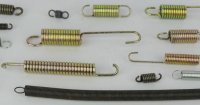一、两边拉弹簧测力计?
是的,弹簧测力计显示一边的拉力大小。因为弹簧测力计的测力原理是利用弹簧和刻度盘,测量时,一边拉着弹簧,一边拉着与刻度盘连接的拉环,所以只有一边与弹簧直接接触,所以弹簧测力计只显示与弹簧相连接的一边力。
二、弹簧测力计两边都受力怎么计算?
弹簧测力计两边都受力是一对大小相等,方向相反的一对作用力于此反作用力。
三、弹簧测力计的弹簧断了?
弹簧测力计的弹簧其整条弹簧各段的应力是均匀的.少了一小段.测量值会按一定的比率下降.随拉力的加大负差也越大.如断的只是端点的钩,留下的部份还能拗成钩.没动到圈的部份,校准零点就不变.
四、弹簧的并联-物理弹簧测力计/当弹簧测力计串联以?
设每个弹簧弹性系数为k,n个弹簧并联伸长x,则总共拉力是nkx,自然就扩大了量程。而串联的弹簧每个的拉力都相等且必须在单个弹簧量程之内。
五、如果弹簧测力计两边都受力的话弹簧测力计显示的力是哪边的力?
弹簧测力计显示的是被测物体的重力.在地球上就是和质量数值相等但意义不一样,在月球上则为地球上的几分之一.一边固定,另一边拉就相当于两边拉, 这两种情况是一回事。 比如一边固定在墙壁上(固定在任何物体上道理一样),实际上就是墙壁在拉着。
六、弹簧测力计公式?
F=kx,F为弹力,k为劲度系数,x为弹簧拉长的长度
七、弹簧测力计量程?
弹簧测力计的量程:表示弹簧测力计在测力计弹簧的弹性限度内所受的力的范围,最小刻度表示测力计的精确度,也就是读数时的最小准确数字。
弹簧测力计的正确使用方法:
1、首先要看清弹簧测力计的量程,加在弹簧测力计上的力不许超过它的量程;
2、明确分度值,即一小格表示的力的大小;
3、校零:测力前要使指针对准零刻度线;
4、测力时,要使测力计的弹簧轴线方向跟力的方向在同一直线上,弹簧不能靠在刻度盘上。
八、什么弹簧测力计从左右两边拿同样的力气时显示的是?
把弹簧测力计看作一个质点就好理解了。
如果你不信的话,你可以根据胡克定律来做实验验证。
是的,弹簧测力计显示一边的拉力大小。因为弹簧测力计的测力原理是利用弹簧和刻度盘,测量时,一边拉着弹簧,一边拉着与刻度盘连接的拉环,所以只有一边与弹簧直接接触,所以弹簧测力计只显示与弹簧相连接的一边力。
九、手要提着弹簧测力计的什么?使用弹簧测力计?
在使用弹簧测力计时。如果若误将弹簧测力计上下拿反,把物体挂在了拉环上。测量结果与实际值相比读数会偏大的。弹簧测力计是一种常见的测量力的工具,可以测量拉力或物体的重力。在使用时的要求;
①使用弹簧测力计时,首先要调零,再观察弹簧测力计的量程和分度值。
②测量中,测力计弹簧的轴线方向要与被测量的力作用线的方向一致。
③使用中,不能超过弹簧测力计的量程。实际测量中,被测的力作用在秤钩上,手拿着上部的拉环,使弹簧测力计的轴线方向与被测力的作用线方向相同。待示数稳定后读出读数,该读数就是这个力的大小了。如果测量中,错把被测量的力作用在拉环上了,手拿着秤钩部分。那么,这样测量的结果就会偏大了。因为,此时的读数包括被测物体的重力和弹簧测力计壳体的重力,所以测量结果会比实际值偏大了。
十、弹簧制作弹簧测力计
弹簧制作与弹簧测力计的重要性
弹簧作为一种重要的机械零件,在各个行业和应用中都有广泛的使用。无论是汽车工业、航空航天、家电制造还是医疗设备,弹簧的质量和性能都是至关重要的。而在弹簧制作过程中,弹簧测力计起着不可或缺的作用。
弹簧制作需要经过一系列严谨的步骤。首先,我们需要选择合适的弹簧材料。这取决于弹簧所需的强度、硬度和耐腐蚀性。常见的弹簧材料包括不锈钢、高碳钢和合金钢。通过选择合适的材料,我们能够确保弹簧具有良好的弹性和耐用性。
接下来,是弹簧的设计和制造过程。弹簧的设计需要考虑到其所需的弹性系数、形状和尺寸。这些参数将直接影响到弹簧的力学性能和应用场景。制造弹簧时,需要使用专业的设备和工具,如弹簧机和弹簧夹具。通过精密的加工和控制,我们能够确保弹簧的制作质量和一致性。
然而,仅仅制作一个符合要求的弹簧还不够,我们还需要对其进行质量和性能的检测。这就是弹簧测力计发挥作用的地方。弹簧测力计是一种专门用于测量弹簧的力学特性和性能的设备。它能够帮助我们评估弹簧的弹性系数、荷载能力、疲劳寿命和变形特性。
弹簧测力计工作的原理是通过施加力量来测量弹簧的变形。我们可以将弹簧安装在测力计上,施加不同大小的力量,并记录弹簧的变形情况。通过分析得到的数据,我们能够得出弹簧的力学特性曲线和性能指标。
弹簧测力计可以用于多种弹簧的测试和评估。比如,我们可以使用弹簧测力计来测试压缩弹簧的变形性能和可靠性。同样地,我们也可以使用它来测试拉伸弹簧和扭转弹簧的性能。通过这些测试,我们能够及时发现弹簧的质量问题,确保其在实际应用中的安全可靠性。
弹簧制作与测力计的结合,为弹簧行业提供了一种科学和有效的质量控制手段。它既可以用于弹簧的初始生产阶段,也可以在弹簧的使用过程中进行定期检测和维护。通过合理使用测力计,我们能够最大程度地提高弹簧的质量和可靠性。
此外,弹簧制作与弹簧测力计的重要性还体现在新产品开发和技术创新方面。随着科技的进步和需求的变化,越来越多的新类型弹簧被开发出来。弹簧制造商需要使用测力计对新型弹簧的性能进行评估和改进。通过测力计的帮助,我们能够及时发现和解决新型弹簧的问题,为弹簧行业的创新发展做出贡献。
总之,弹簧制作与弹簧测力计的重要性不可忽视。优质的弹簧是各行各业的基础和保障,而测力计则是确保弹簧质量和性能的重要工具。只有通过合理的制作和准确的测试,我们才能获得符合要求的弹簧产品,并确保其在实际应用中的可靠性和安全性。
Translation: htmlThe Importance of Spring Manufacturing and Spring Force Measurement
As an important mechanical component, springs are widely used in various industries and applications. Whether in the automotive industry, aerospace, home appliance manufacturing, or medical devices, the quality and performance of springs are crucial. In the process of spring manufacturing, spring force measurement plays an essential role.
Spring manufacturing involves a series of precise steps. First, we need to select suitable spring materials. This depends on the required strength, hardness, and corrosion resistance of the spring. Common spring materials include stainless steel, high carbon steel, and alloy steel. By choosing the appropriate materials, we ensure that the spring has excellent elasticity and durability.
Next comes the design and manufacturing process of the spring. The design of the spring needs to consider its required spring constant, shape, and size. These parameters directly influence the mechanical performance and application scenarios of the spring. During the manufacturing process, specialized equipment and tools such as spring machines and spring fixtures are used. Through precise processing and control, we can ensure the manufacturing quality and consistency of the springs.
However, it is not enough to produce a compliance spring; we also need to test its quality and performance. This is where spring force measurement comes into play. Spring force measurement is a device specifically used to measure the mechanical characteristics and performance of springs. It helps us evaluate the spring's spring constant, load capacity, fatigue life, and deformation characteristics.
The principle behind spring force measurement is to measure the spring's deformation by applying force. We can install the spring on the force measurement device, apply forces of different magnitudes, and record the spring's deformation. By analyzing the obtained data, we can derive the spring's mechanical characteristic curve and performance indicators.
Spring force measurement can be used for testing and evaluating various types of springs. For example, we can use spring force measurement to test the deformation performance and reliability of compression springs. Similarly, we can also use it to test the performance of tension springs and torsion springs. Through these tests, we can promptly identify quality issues with the springs, ensuring their safety and reliability in practical applications.
The combination of spring manufacturing and force measurement provides a scientific and effective means of quality control for the spring industry. It can be applied both during the initial production stage of springs and during regular testing and maintenance throughout their lifespan. By utilizing force measurement properly, we can maximize the quality and reliability of springs.
Furthermore, the importance of spring manufacturing and force measurement is also reflected in new product development and technological innovation. With technological advancements and changing demands, more and more new types of springs are being developed. Spring manufacturers need to use force measurement to evaluate and improve the performance of these new springs. With the help of force measurement, we can quickly identify and solve problems associated with new types of springs, contributing to the innovative development of the spring industry.
In conclusion, the importance of spring manufacturing and force measurement should not be underestimated. High-quality springs serve as the foundation and guarantee for various industries, while force measurement devices ensure the quality and performance of springs. Only through proper manufacturing and accurate testing can we obtain compliant spring products and ensure their reliability and safety in practical applications.

 249
249 2024-04-21 00:50
2024-04-21 00:50 admin
admin
